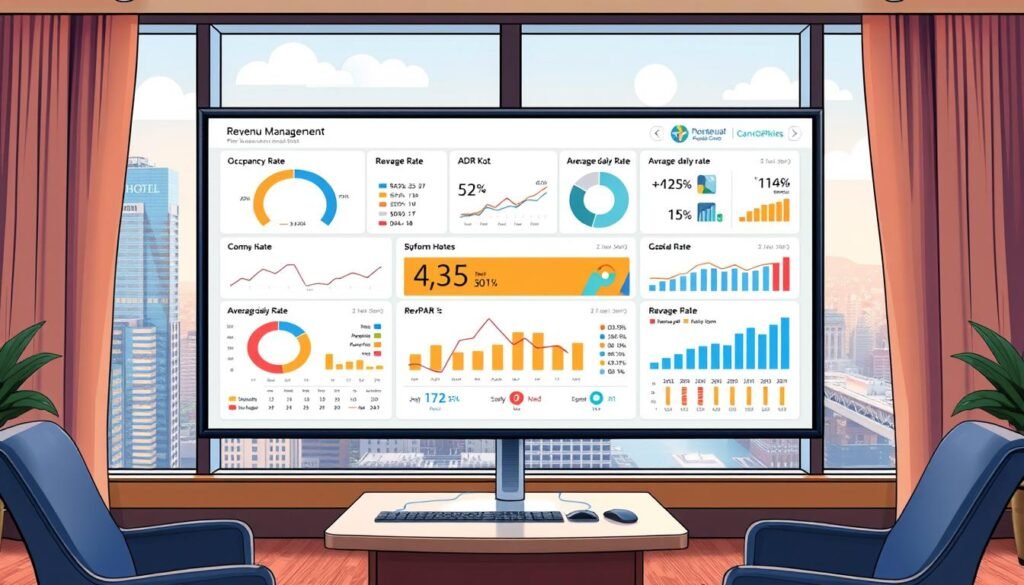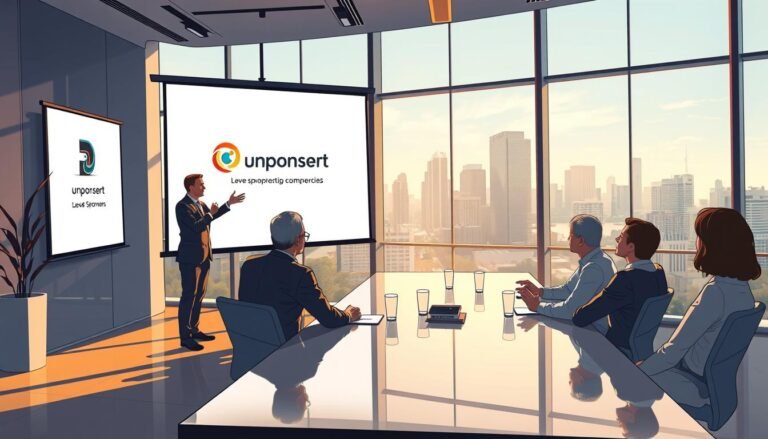Revenue management in hotels
Revenue management in hotels is more than just setting room prices. It’s about matching guests with the right rate at the right time. Hotels that use smart strategies can see up to 30% more revenue. Yet, many still guess instead of using data.
Imagine knowing when to raise rates for luxury suites during a music festival. Or when to offer discounts to fill rooms. This is the power of revenue management. It uses data to make decisions, not guesses.
This guide shows how hotels can make more money without losing guests. They do this by balancing prices, where they sell rooms, and how guests behave. It’s all about making smart choices with the right tools.
Key Takeaways
- Revenue management boosts revenue by optimizing pricing and inventory across all hotel services.
- Dynamic pricing tools adjust rates in real time based on competitor moves and demand spikes.
- Modern RMS systems combine PMS and CRM data to forecast trends and improve decision-making.
- Effective hospitality revenue strategy balances OTA bookings with direct reservations to avoid parity penalties.
- Guest segmentation uncovers hidden opportunities in upselling amenities or bundling F&B with room bookings.
Understanding the Fundamentals of Revenue Management in Hotels
Revenue management in hotels is about making more money by setting the right prices for rooms. It matches room rates, inventory, and where rooms are sold with what guests want. This way, hotels sell rooms to the right people at the best prices. It’s all about finding that balance between selling rooms and making money.
By using data to make smart choices, hotels can increase profits by 20-30%. This is thanks to strategies that use information to guide decisions.
What Is Revenue Management and Why It Matters
Revenue management in hotels is about making more money without having more rooms. It started in the 1970s with airlines, where seats are like hotel rooms—something that can’t be kept forever. Today, hotels use it to understand what guests want, set prices on the fly, and manage how many rooms they offer.
This approach helps hotels improve their bottom line. It’s all about boosting metrics like RevPAR and GOPPAR.
The Evolution of Revenue Management in the Hospitality Industry
At first, revenue management was simple. Now, it’s all about using advanced tools like Property Management Systems (PMS) and Revenue Management Systems (RMS). These tools help hotels analyze data in real-time.
Today, hotels use machine learning, look at what competitors are doing, and even check social media to guess what guests will want. This is key in a world where what guests want changes fast.
Key Principles That Drive Successful Revenue Management
- Market Segmentation: Categorizing guests based on booking channels, demographics, and spending habits.
- Price Elasticity: Testing how price changes affect demand for rooms.
- Forecasting: Using historical data and external factors (e.g., events, seasons) to predict demand.
- Inventory Control: Adjusting availability to match demand and maximize revenue.
These principles help hotels avoid selling rooms too cheaply or not selling them at all. By using these strategies, hotels can keep up with the market and stay profitable.
Setting Up Your Hotel Revenue Management Strategy
Creating a hospitality revenue strategy means matching your goals with your hotel’s needs. Begin by looking at how you’re doing now to find areas to improve. Use flexible methods that focus on what guests want and aim to make more money. Here’s how to start:
- Use dynamic pricing tools like Lighthouse or Revfine to adjust rates in real time.
- Set inventory limits using stay restrictions during busy periods to boost occupancy.
- Divide guests into segments (leisure, corporate) to tailor promotions and pricing.
- Invest in AI-driven systems like Cloudbeds or RoomPriceGenie Academy for automated decisions.
| Strategy | Benefit | Tool Example |
|---|---|---|
| Dynamic Pricing | Matches demand fluctuations | Lighthouse |
| Market Segmentation | Targets diverse traveler types | RevPAR analysis tools |
| AI Technology | Automates forecasting and booking patterns | Revenue Hub |
Training your team with programs like Revenue Hub’s courses helps everyone work towards your goals. Keep an eye on what your competitors are doing with tools that track their prices. Update your strategy often using past data and upcoming events. A good hospitality revenue strategy combines these steps for revenue maximization for hotels. Stay flexible, use technology, and keep your team on the same page for success.
Market Segmentation: The Foundation of Effective Revenue Optimization
Market segmentation changes revenue management in hotels by grouping guests. It makes sure strategies match what travelers want. This leads to more profit and guest happiness. Hotels can make more money by understanding who stays with them.
Identifying Your Key Market Segments
Start by sorting guests with tools like PMS and CRM systems. You can group them into types like business travelers, corporate clients, and groups. Look at how they book and what they spend to find the best ways to make money.
Tailoring Your Approach to Different Guest Types
- Offer corporate clients discounted rates with guaranteed stays.
- Appeal to leisure travelers with package deals combining rooms and activities.
- Highlight amenities like meeting spaces for event planners.
Using Segmentation to Drive Pricing Decisions
Change prices based on what each group wants. Business travelers might pay more for flexible plans. Budget guests like early discounts. AI helps make these decisions better, so everyone gets a good deal.
Segmentation helps decide where to spend on marketing and how much to offer. Hotels that do this well see 15-20% more revenue. Start by looking at past guest data to find out who’s most valuable.
Demand Forecasting Techniques for Hoteliers
Accurate revenue forecasting in hospitality begins with knowing past and present trends. This knowledge helps hotels set the right prices and manage their rooms. It ensures their plans match the real demand. Let’s look at how data can lead to smart decisions.
Historical Data Analysis Methods
Look at past performance with metrics like Average Daily Rate (ADR) and RevPAR. Tools like time-series analysis track booking trends. Regression models help find out what affects demand, like seasons.
For example, a resort might see more bookings in July. They can then adjust their rates.
Market Trend Evaluation
- Keep an eye on economic changes, like tourism growth or competitor pricing.
- Watch OTA rankings and compset rates for chances to improve.
- Use tools like Cloudbeds Intelligence, which uses outside data for quick adjustments.
Seasonal Patterns and Special Events Impact
Seasonal demand peaks, like holidays, need rate adjustments. Special events, like conferences, can increase demand. Use booking pace data to adjust room numbers.
For example, a downtown hotel near a convention center might raise rates during trade shows.
| Traditional Methods | AI-Driven Solutions |
|---|---|
| Rely on historical data alone | Combine historical and real-time data (e.g., economic indicators) |
| Static predictions | Adapt to sudden changes like weather or travel restrictions |
| Higher forecast error rates | Machine learning reduces errors by 20-30% (as seen in Hotel A’s 15% RevPAR increase using causal AI) |
By mixing old insights with new tools, hotels can make better forecasts. This leads to smarter revenue management in hotels. It ensures budgets match demand, boosting profits all year.
Dynamic Pricing Strategies That Maximize Revenue
Dynamic pricing is key for hotels today to increase earnings. By changing room prices in real time, hotel rate optimization helps hotels earn more without losing guests. Let’s look at how to use data to make more money.
- Time-based pricing: Raise rates during high-demand events like conferences or holidays.
- Competitor tracking: Match or undercut competitors’ rates during low occupancy, then increase when their inventory drops.
- Segment-specific pricing: Offer premium rates for guests booking last-minute or requesting premium rooms.
| Model | Description | Example |
|---|---|---|
| Competitor-Driven | Adjust prices based on competitor availability and pricing. | Raising rates when a nearby hotel sells out. |
| Seasonal | Align rates with event schedules or weather patterns. | Higher rates during ski seasons or music festivals. |
| AI-Powered | Automated systems analyze data to set optimal prices instantly. | Tools like RezNext or Hotelogix adjust rates in real time. |
Being quick is crucial. For example, if flights get canceled, lowering rates can fill rooms fast. On the other hand, raising rates before a big event can help earn more. Always be clear with prices to keep guests happy. With the right tools and plan, dynamic pricing is a science that makes money from data.
Leveraging Technology for Hotel Revenue Management
Today’s hotel revenue strategies use advanced tools to make smart decisions. Hotel revenue optimization relies on systems that analyze data in real-time and predict future trends. For example, AI platforms like G3 RMS helped The Olympia Companies increase rates by 10% each year. This was achieved by improving revenue forecasting in hospitality practices.
Important software includes revenue management systems (RMS) that handle pricing and inventory automatically. These tools look at past trends, competitor rates, and booking patterns to suggest the best prices. They also adjust rates and forecast group bookings, making it easier for big brands to grow.
- Automated pricing engines adjust rates in real time based on demand spikes or events
- Machine learning models predict occupancy trends using data from past bookings and market shifts
- Integration with PMS and CRM systems streamlines inventory tracking and guest engagement
Data analytics tools reveal insights from guest behavior and competitor pricing. Systems like IDeaS use AI and training to help teams use features well. These platforms show chances to upsell suites during busy times or adjust online listings quickly.
Channel managers keep inventory the same across different booking sites, ensuring everything matches. Training from IDeaS teaches teams to understand and act on data. When combined with CRM tools like Tripleseat, these systems turn data into strategies to boost revenue.
Distribution Channel Optimization for Greater Profitability
Mastering hospitality revenue strategy means finding the right balance in distribution channels. Direct bookings from a hotel’s website or call center offer higher margins. But, OTAs like Booking.com and Expedia bring in more guests. This guide shows how to make the most of every channel without losing profit.
| Channel | Pros | Cons | Optimization Tips |
|---|---|---|---|
| Direct Bookings | No fees, customer data | Lower reach | Website discounts, loyalty rewards |
| OTAs | Large audience | 15-30% fees | Negotiate commission rates, use marketing credits |
| GDS | Corporate travelers | High fees | Target group bookings |
| Metasearch | Increased visibility | Pay-per-click costs | Bid strategically on high-value keywords |
Boost direct reservations with personalized offers. Hotels using email campaigns to reward returning guests see a 15% rise in direct bookings. Add urgency with limited-time discounts, but ensure rate parity compliance. Mobile-friendly websites and AI chatbots improve user experience, driving conversions.
OTAs accounted for 40% of U.S. bookings in 2021. Negotiate exclusive rates for loyal customers while maintaining competitive pricing. Use OTA marketing credits for targeted ads instead of paying full commissions. Monitor reviews daily to maintain brand reputation.
Optimal channel mix requires analyzing true costs. A 2023 study shows hotels without channel managers lose 20% potential revenue. Use tools like RezNext or ChannelManager to track performance. Aim for 40-50% direct bookings to balance visibility and margins.
By aligning these strategies, you can create a hospitality revenue strategy that boosts profits without losing reach. Regularly check how each channel is doing to make sure every booking helps your long-term success.
Upselling and Cross-selling Techniques for Increased Revenue
Upselling and cross-selling are revenue generation techniques in hotels that make ordinary stays special. Upselling means offering guests better options, like room upgrades. Cross-selling adds extra services to what they already booked. Both ways help hotels earn more without spending more.
| Upselling | Cross-selling |
|---|---|
| Room upgrades, premium suites, or spa packages | City tours, dining vouchers, or event bookings |
| Increases average room rate | Encourages additional spending during stays |
| Example: Upgrading to a suite with a balcony view | Example: Pairing a stay with a wine tasting at check-in |
To maximize revenue, timing is key. Upsells work best during booking or check-in. Cross-sells suggest local experiences, like guided hikes. Use tools like Little Hotelier to make these offers automatic, increasing revenue by up to 46%.
Here’s how to implement:
- Train staff to spot upsell moments (e.g., group bookings for event AV rentals).
- Bundle add-ons: Combine spa discounts with room bookings.
- Track KPIs like upsell conversion rates and guest satisfaction scores.
Success depends on offering real value. Guests like suggestions that improve their stay, not pushy sales. A friendly, knowledgeable approach can turn small ideas into big gains.
Revenue Performance Analysis: Metrics That Matter

Tracking the right metrics turns raw data into actionable insights for revenue performance analysis. Start with RevPAR, which combines occupancy and average daily rate (ADR) to gauge room revenue efficiency. For example, a 150-room hotel boosted peak-season revenue by 12% after refining forecasts for local events.
| Metric | Formula | Key Insight |
|---|---|---|
| RevPAR | Total Room Revenue ÷ Total Rooms Available | Measures room revenue efficiency |
| GOPPAR | Gross Operating Profit ÷ Rooms Available | Shows profitability after operating costs |
| TRevPAR | Total Revenue ÷ Rooms Available | Includes all revenue streams |
| RevPOR | Total Revenue ÷ Occupied Rooms | Tracks upselling success |
Hotel yield management thrives when dashboards display these metrics together. One hotel cut CPOR by $10/room, saving $292,000 annually. Another boosted GOPPAR by 15% after cost controls. Pair these numbers with market penetration and revenue generation indexes to compare against competitors. Monitor direct booking ratios and website conversion rates to optimize digital performance.
Effective revenue performance analysis requires balancing occupancy, pricing, and cost controls. Use dashboards to track progress toward goals like improving flow-through percentages or increasing TRevPAR. These tools turn data into decisions that drive profitability.
Managing Rate Parity Across Booking Channels
Rate parity means hotel rates are the same everywhere. If not, hotels face penalties and lose customer trust. For example, Hotel Seaside Retreat always charges $200 for its ocean-view suite, no matter where it’s booked.
There are two types of parity: wide parity and narrow parity. Wide parity means the same rate everywhere. Narrow parity allows for discounts on certain channels. Here’s a look at their pros and cons:
| Type | Description | Pros | Cons |
|---|---|---|---|
| Wide Parity | Uniform pricing across all channels | Builds trust, avoids penalties | Risk of losing direct-booking incentives |
| Narrow Parity | Lower rates for select channels | Encourages direct bookings | Potential for OTA undercutting |
Tools like SiteMinder and Parity Insight watch over 2 billion rates daily. They fix any rate issues automatically. This helps hotels avoid losing money due to outdated prices or tax mistakes. Some strategies include:
- Offering free upgrades or perks instead of discounted rates
- Using metasearch ads to boost visibility without breaking parity
- Automating updates via channel managers
Most top hotel chains, 80%, use Parity Insight to keep rates in check. Sticking to parity helps meet hospitality revenue strategy goals and optimize hotel rate optimization. Finding the right balance between parity and guest rewards is key to long-term success.
Building an Effective Revenue Management Team
For hotels to succeed, they need a team that gets data, pricing, and guest behavior. Start by defining roles and encouraging teamwork. Here’s how to build a team that drives success.
Key Roles and Responsibilities
- Revenue Manager: Oversees pricing, inventory, and KPIs like RevPAR and GOPPAR.
- Data Analyst: Analyzes historical trends and market data to forecast demand.
- Channel Manager: Ensures rate parity across OTAs and direct bookings.
Training and Skill Development
Keep your team up-to-date with tools like revenue management systems (RMS) and dynamic pricing. Use:
- Online courses on data analytics and yield management.
- Webinars from industry leaders to learn best practices.
- On-demand training videos focused on KPI tracking and competitor analysis.
Invest in certifications like those from hospitality education platforms to build expertise.
Breaking Silos: Cross-Department Synergy
Revenue teams must work with sales and marketing to align campaigns with pricing strategies. For example, marketing teams can promote last-minute deals when occupancy is low. Front desk staff should share guest feedback to refine pricing. Regular cross-department meetings ensure everyone understands how their role impacts revenue management in hotels.
By uniting these efforts, hotels can optimize inventory, boost occupancy, and achieve higher profitability through teamwork and shared goals.
Common Revenue Management Challenges and How to Overcome Them
Hoteliers often face big challenges that block revenue maximization for hotels. One major issue is data fragmentation. This means having incomplete booking histories or systems that don’t talk to each other. A 2023 AHLA study found that 97% of hotels struggle with not having enough staff, which slows down making decisions.
But, there are solutions. Start by putting all your data into one place. Tools like RevPAR Genius or IDeaS can help with this.
Another big challenge is getting teams to change. They might stick to old pricing methods even when hotel revenue optimization tools are available. To fix this, train your staff on systems like Overture or Duetto.
Automating simple tasks can save up to 60% of weekly hours, according to a Google/Bain report. This frees up time for more important work.
- Market volatility? Blend competitor analysis with seasonal trends when historical data lacks.
- Low demand? Avoid panic discounts. Partner with local attractions for bundled offers instead.
- OTA dominance? Allocate 30% of budgets to direct booking campaigns—email nurture sequences boost loyalty.
OTA commissions now control 40% of travel sales, but hotels can fight back. Use tools like RateGain or ChannelManager to keep prices the same everywhere. Also, focus on getting more direct bookings.
Don’t forget to train your staff. Learning about revenue software can cut errors by 40%. By tackling these challenges, hotels can grow without losing their brand value.
Case Studies: Successful Hotel Revenue Management Implementations
Real-world examples show how hotel yield management changes hotel performance. These case studies highlight revenue generation techniques in hotels. They show how these techniques boosted profits across different property types.
| Property | Strategy | Outcome |
|---|---|---|
| Luxury Hotel Chain (Taormina Resort) | Centralized RM teams, dynamic pricing | RevPAR +39%, room revenue ↑€655K |
| Boutique Hotel (Palermo) | Rate fences, channel optimization | ADR ↑€44.38, revenue +23% |
| Independent Property | Local market focus, value packages | $100K–$200K annual increase |
Key strategies from these revenue generation techniques include:
- Centralized revenue teams for large chains
- Rate adjustments for boutique properties
- Direct booking emphasis for independents
These success stories prove that even small properties can thrive. The Taormina resort’s centralized approach raised rates and occupancy. The Palermo hotel cut third-party reliance, boosting profits.
The independent property’s localized packages drove direct bookings and higher ADRs. Each case shows how tailored hotel yield management strategies unlock growth opportunities.
Conclusion: Taking Your Hotel’s Revenue Management to the Next Level
Revenue performance analysis is crucial for hotels to find new ways to make money. Tools like Duetto, IDeaS, and RateBoard help track demand and adjust prices. This way, hotels can offer the right deals to guests, making every booking count.
Good revenue forecasting in the hotel industry uses past data and what competitors do. Tools like RevPar Guru and Kepion make it easier to find chances to make more money. Start by checking your current KPIs like RevPAR and how full your hotel is. Even small changes, like better OTA listings or loyalty programs, can help a lot.
Use technology to stay ahead. Work together with different teams to make sure everyone is on the same page. Whether it’s trying out AI tools or improving how you segment guests, always keep analyzing and adjusting. With the right plan, hotels can turn revenue management into a key advantage that helps them succeed for years to come.
Source Links
- Hotel Revenue Management Strategies and Solutions – https://www.siteminder.com/r/hotel-revenue-management/
- What is hotel revenue management? The ultimate guide – https://www.cloudbeds.com/revenue-management/
- The ultimate guide to revenue management in hotels – https://www.glion.edu/magazine/revenue-management-in-hotels/
- The Fundamentals of Revenue Management: The Cornerstone of Revenue Strategy – https://www.coursera.org/learn/fundamentals-of-revenue-management
- 12 revenue management strategies and best practices from leading hospitality experts – https://www.cloudbeds.com/revenue-management/strategies/
- 10 Tried and true hotel Revenue Management strategies – https://www.mylighthouse.com/resources/blog/10-tried-and-true-hotel-revenue-management-strategies
- Hotel market segmentation | A step by step guide by Mews – https://www.mews.com/en/blog/hotel-market-segmentation
- Benefits of Focused Market Segmentation in Hotels – https://www.linkedin.com/pulse/benefits-focused-market-segmentation-hotels-anders-johansson-bfgzf
- Benefits of Focused Market Segmentation in Hotels – https://www.demandcalendar.com/blog/benefits-of-focused-market-segmentation-in-hotels
- Hotel forecasting: Revenue, methods and reports – SiteMinder – https://www.siteminder.com/r/hotel-forecasting/
- How decision intelligence unlocks hotel data for better insights – https://www.cloudbeds.com/articles/hotel-demand-forecasting/
- Demand Forecasting: Hotel Revenue Management Explained – Prosper Hotels – https://www.prosperhotels.com/blog/demand-forecasting-hotel-revenue-management-explained/
- Hotel dynamic pricing: Full guide with examples | SiteMinder – https://www.siteminder.com/r/hotel-dynamic-pricing/
- Dynamic pricing strategies for maximizing hotel revenue – https://hospitalityinsights.ehl.edu/dynamic-pricing-maximizing-revenue-hotel-industry
- What is dynamic pricing in hotels and how does it work? – https://www.mews.com/en/blog/dynamic-pricing-hotels
- Hospitality Technology Trends: How AI Is Revolutionizing Hotel Revenue Management – https://ideas.com/hospitality-technology-trends-ai-hotel-revenue-management/
- Leveraging Technology for Smart Revenue Management in Hospitality – https://www.linkedin.com/pulse/leveraging-technology-smart-revenue-management-yuri-hidalgo-alonso-lu5af
- How Leveraging the Right Technology Will Boost Hotel Revenue – https://tripleseat.com/blog/how-leveraging-the-right-technology-will-boost-hotel-revenue/
- Hotel Distribution Channels- Types & Strategies to Optimize – https://blog.hotelogix.com/hotel-distribution-channels/
- Distribution Channel Strategy: The Path to Profitability – https://ideas.com/distribution-channel-strategy-the-path-to-profitability/
- How to Optimize Your Channel Manager for Better Distribution and Revenue – https://www.seekda.com/en/post/how-to-optimize-your-channel-manager-for-better-distribution-and-revenue/
- Hotel Upselling – Cross-Selling Revenue Strategies – https://www.hotelminder.com/hotel-upselling-cross-selling-guide
- Upselling in hotels: Techniques and examples | Little Hotelier – https://www.littlehotelier.com/blog/increase-your-revenue/what-is-upselling-hotel/
- The Final Four of Hotel Revenue: The Metrics That Actually Matter – https://www.m3as.com/hotel-profitability-metrics-final-four/
- How to calculate and improve 12 hotel performance metrics – https://www.mylighthouse.com/resources/blog/calculate-and-improve-hotel-performance-metrics
- Hotel Industry’s 14 Most Critical Metrics – Guiding Metrics – https://guidingmetrics.com/content/hotel-industrys-14-most-critical-metrics/
- What is hotel rate parity? | SiteMinder – https://www.siteminder.com/what-is-hotel-rate-parity/
- A parity system that helps hotels uncover and overcome parity issues – https://www.mylighthouse.com/resources/blog/parity-system-for-hotels
- The Essential Guide to Revenue Management for Hotel Owners/Operators, Hotel Managers & Front Desk Managers – https://hospitalitytech.com/essential-guide-revenue-management-hotel-ownersoperators-hotel-managers-front-desk-managers
- Top 11 revenue management challenges for hospitality professionals & hoteliers | IDeaS – https://ideas.com/revenue-management-challenges-for-hoteliers/
- Best Methods to Increase Your Hotel ADR8 Challenges for Implementing a Revenue Management Strategy – https://revnomix.com/8-challenges-for-implementing-a-revenue-management-strategy/
- Hotel Revenue Management Case Study – Crete Greece – https://www.linkedin.com/pulse/hotel-revenue-management-case-study-revitup-direct
- Hotel Revenue Management in Italy | Case Studies in Hotel Turnaround Strategies – https://www.xotels.com/en/revenue-management/hotel-revenue-management-in-italy-case-studies-by-xotels
- Hotel Revenue Management Case Studies: Real-World Examples of Success – https://planethms.com/hotel-revenue-management-case-studies-real-world-examples-of-success/
- Hotel Revenue Management: Strategies, Tools, and Best Practi – https://www.altexsoft.com/blog/hotel-revenue-management-solutions-best-practices-revenue-managers-role/
- The 10 most effective hotel revenue management strategies – https://www.mews.com/en/blog/hotel-revenue-management-strategies








